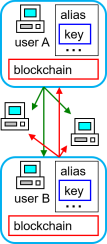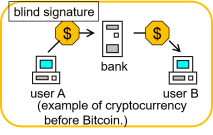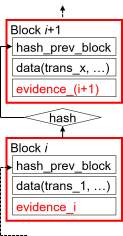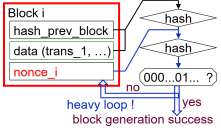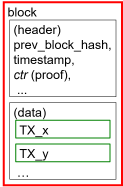| blochchain |
- distributed ledger
- block : each page of the ledger
- chain : ledger of binded pages
- shared information (ledger) by all parties
- "consensus"† among parties.
- periodic update of ledger
- collecting new data,
- generating a block periodically,
- appending it to the chain.
|
| [2] J. Bonneau, A. Miller, J. Clark, A. Narayanan, J. A. Kroll, E. W. Felten, "SoK: Research Perspectives and Challenges for Bitcoin and Cryptocurrencies", In 2015 IEEE Symposium on Security and Privacy, pp.104-121 (May 2015) |
|
|
| Bitcoin [3] |
| [3] Satoshi Nakamoto, "Bitcoin: A peer-to-peer electronic cash system", https://bitcoin.org/bitcoin.pdf (2009) |
- implementation of a cryptocurrency using blockchain.
- cryptocurrency
- decentralized
- no trustded third party (bank, mint).
- parties connecting by P2P network.
- wallet
- transaction
|
 |
|
|
| mechanism of blockchain |
- data sharing among all participating parties
- transmitting new data form/to one another.
- update by new data collection
- generating a block periodically by new data collection.
- if succeeded, the block will be broadcasted.
- sharing and updating in a reliable manner.
- slection method of a party of block generation.
- accepting only a block with valid data.
- attainable security (sound blockchain)
- consensus on a single valid chain.
- In case one party evaluate one data in a chain as valid, others also do so.
- A valid data settles in a chain in a certain period of time.
|
|
|
| how to generate a block in Bitcoin ([2], etc.) |
- "proof-of-work"† type
- calculating a partial inversion of hash function.
- evidence : nonce with which the block hash is less than the assigned value.
- all the paricipating nodes can generate a block (probabilistically).
- "miner"
- a node, who found a successful nonce, earns some "coin"
(: mining reward, transaction fees).
... called a "miner" (mining node).
- competing among miners for earning coins.
|
|
|
| data structure in Bitcoin [4] |
- chain
- block
- TX (data) container.
- ctr (proof) (... not easy to make)
- TX ("transaction"†).
- mempool
- a pool of TXs.
- created, but not in the chain.
- UTXO table
- unspent transaction output table of TX output in the chain, which is unspent.
|
| [4] BitcoinCore, https://github.com/bitcoin/bitcoin/ |
|
|
| workload of a miner in Bitcoin [3,4] |
- (as a node in P2P network)
- receiving TXs.
- validity check of them
(checking with UTXO table, mempool).
- updating UTXO table, mempool.
- receiving blocks.
- validity check of them
(checking with a chain, UTXO table, mempool).
- updating a chain, UTXO table, mempool.
- creating and sending TXs (if necessary).
- (in the node)
- TX validity check
- checking if valid format.
- finding corresponding outputs in UTXO table (and mempool) to its inputs.
- checking if not double-spending.
- script verification.
- reading and checking all scripts in TX.
- signature verification.
... cryptographic computation (maybe heavy).
- block validity check
- checking on proof-of-work.
- checking if valid format.
- checking timestamp.
- checking TXs in it.
- Rushing miners have an incentive to skip validity checks.
- (pros)
- shifting computational power into proof-of-work trials.
- no need to maintain UTXO table.
- (cons)
- possibility of accepting invalid TXs (and blocks).
- ... possibility of generating a block with invalid TXs.
|
|
|
| proof-of-verification [1] |
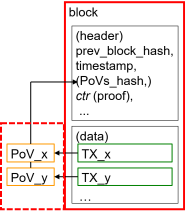 |
- issue
- The more invalid TXs (and invalid blocks) are propagated in the system,
the less soundness the system attains.
- desired functionality
- checking if a block is generated by validity-checked TXs.
- light-weight (for block verifiers).
- little additional workload (for miners).
In signature verification process, there is a value such that ...
- an inevitably-calculated intermediate variable,
- not pre-computable,
- requiring some computation
(not too light compared to total computation of signature verification).
... employed as a PoV data of the TX.
- PoV-related data in a block
- (method 1)
A block hash value is calculated with a hash value(s) of PoV data of all TXs.
- Then the block hash depends on all PoV data.
- (variation 1-1)
- All hash values of TX PoV data are contained in the block.
- (Hash(All PoV data) can be stored in the block header.)
- (variation 1-2)
- No PoV data of TXs are contained in the block.
- "Hash(All PoV data)" is stored in the block header.
- For easy (and fast) validity check on proof-of-work,
it is necessary that some PoV-related data is included in the block.
- (method 2)
A hash value(s) of PoV data of all TXs in the block is just concatenated to the block.
- (variation 2-1)
- All hash values of TX PoV data are attached to the block.
- (variation 2-2)
- Only "Hash(All PoV data)" is attached to the block.
- For proof-of-verification functionality (checking a block of skipping validity checks),
it is necessary that some PoV-related data is attached to the block.
- There can be many variations how PoV data are connected to the block
(above variations, and intermediate variations between them).
- no additional computation in miners.
- except for hash calculation of each PoV data.
- additional communication (and stored) data.
- more in "variation ?-1" compared to "variation ?-2".
- the same (or less) computation in nodes checking the block validity.
- In "variation ?-1", validity checks of some randomly selected TXs might be enough.
... less computation than in original Bitcoin.
|
|
|
| example of a PoV data of a TX |
- in ECDSA [5]
- public parameters :
- CURVE (: elliptic curve)
- G : base point of order n (: prime)
- key pair :
- d : (secret) signature generation key
- random integer, [1, n-1]
- Q : (open) verification key ( Q = d * G )
- signature :
- ( r , s ) := Sig( message , d )
- verification :
- key check (Q is a point on CURVE, n * Q = O : identity)
- e = Hash(message)
- c = (s)-1 mod n ,
u1 = e c mod n ,
u2 = r c mod n
- ( x , y ) = u1 * G + u2 * Q
- valid if r == x mod n .
- ... u1 (and u2) can be used as PoV data.
|
| [5] Accredited Standards Committee X9, "American National Standard X9.62-2020, Public Key Cryptography for the Financial Services Industry: The Elliptic Curve Digital Signature Algorithm (ECDSA)", (September 10, 2020) |
|
|
| load evaluation (plan) |
- evaluation method
- experimentally measuring the workload by the processing time.
- environment : "bitcoind" ver.0.18, on Ubuntu 18.0.4 LTS (64bit).
- comparison between ...
- (N) a normal miner (original "bitcoind"),
- (S) an alt-miner who skips signature verification.
| ... |
| There can be some variations in implementation of (S),
in addition to variations in PoV data treatment in a block. |
- just skipping signature verifications,
- skipping all checks in TX (no use of mempool, UTXO table),
- ...
- (V) an alt-miner implemented proof-of-verification.
- some results so far ...
- TX validation check workload
- 32768 TX check ... 2.4% less in (S) than (N).
- block generation workload
- 5 block generation filled with above TXs ... 3.8% less in (S) than (N).
|
| miscellaneous |
- If an ancestor TX of a validity checking TX is in mempool, bitcoind becomes so heavy.
- in TX validation check, block generation.
|
|
|
| notices |
- more efficient, in case large blocks are allowed.
- In "variation ?-1", TX validity check of a block by random sampling might be acceptable.
- Then fixed number of TX validation check is allowed,
even in case the number of TXs in one block is increased.
- On the contrary, the number of TX validity check in block validity check process will be increased in original Bitcoin.
- no concern on mining pools.
- In mining pool, it is possible to maintain the pool system such that
the pool manager collects TXs, checks their validity
and distributes a (candidate) block to participants in the pool.
Then each participating node can try on proof-of-work of the block
without checking validity by itself.
|
|
|
| † These terms does not strictly mean the same things in existing terminology. |
|
IIS Open House 2024, Matsuura Lab.
